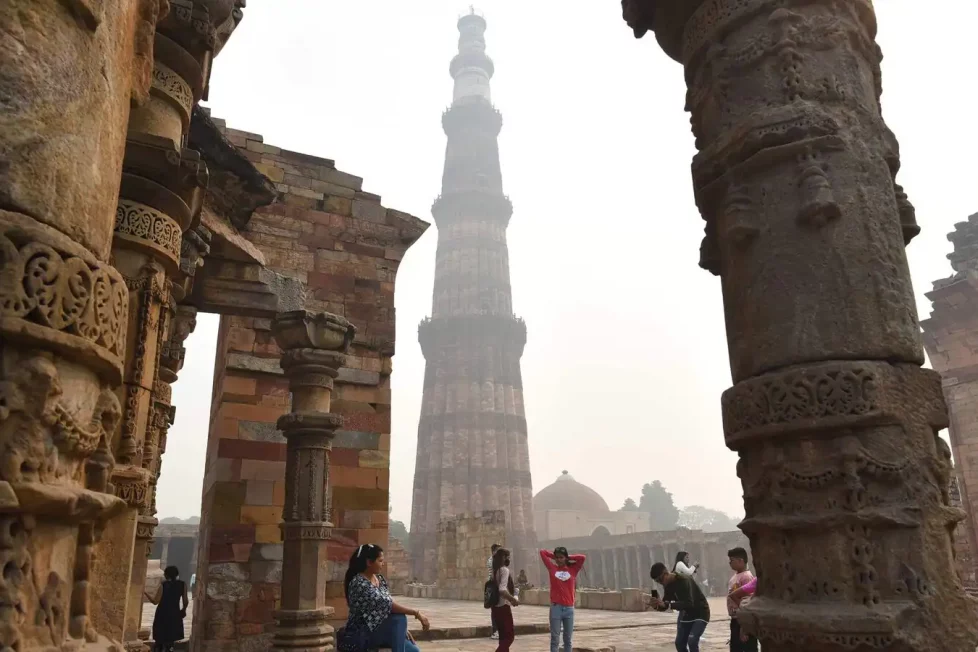Lord Ganesha idols made visible in Qutub Minar after ASI removes iron mesh


The two iron meshes at Qutubminar’s Kuwwat-ul-Islam mosque were removed by the Archeological Survey of India (ASI), which made the presence of Lord Ganesha’s idols visible. The Vishwa Hindu Parishad and other Hindu organizations demanded that the iron mesh be removed.
Two iron meshes had previously protected the Lord Ganesha idols. ASI has now cleaned the idols and placed bulletproof glass over them.
The idol was thought to be standing upside down. But it is now clear that the idol is standing straight. However, ASI has not authorized travelers to perform puja in honor of the deity.
In order to build the mosque, Qutubbuddin Aibak is said by several Hindu organizations to have destroyed 27 Hindu and Jain temples.
The National Monuments Authority requested the ASI to remove the Ganesha sculptures from the Qutub Minar complex earlier this year because their location there is “disrespectful.”
However, a Delhi court mandated that ASI keep things as they are. A petition against the ASI’s proposal to take down the Ganesha idols was being heard in court.
Ulta Ganesh and Ganesha in a cage are the names of the two idols. They can be located inside the complex, which is a UNESCO World Heritage Site.
In addition, the Hindu organizations are engaged in a drawn-out legal battle to maintain their right to worship Shringar Gauri, a god allegedly discovered on the exterior wall of the Gyanvapi Mosque, which is close to the historic Kashi Vishvanath Temple.
Recently, the district court denied the intervention plea for the restoration of Hindu and Jain deities in a purported temple complex inside Qutub Minar since the applicant was not an essential part of the appeal and his argument was without value.
The petitioner was neither a necessary party in the current appeal nor a proper party. Therefore, the application had no merit. In a ruling dated September 20 Additional District Judge Dinesh Kumar said that it was dismissed and handled accordingly.
The court was considering the petitioner Kunwar Mahender Dhwaj Pratap Singh’s intervention request. He claimed to be the owner of land parcels in numerous towns in and around Delhi, including the property of the Qutub Minar, and to be an heir to the former monarch of the “United Province of Agra.”
The applicant argued to be a necessary party in the appeal because he was the legitimate and legal owner of the property that was the subject of the initial lawsuit.
The petitioner claimed that the union government had wrongfully designated Qutub Minar as a protected monument and unlawfully acquired possession of the land in question. The court disagreed and rejected the applicant’s argument.
The site in question was listed as a protected monument in 1914, and the applicant has admittedly not been in control of the property for more than a century, the court said.
It stated that the claim was presumptively time-barred by limitation because the petitioner had not offered any proof that he was the legitimate owner of the subject property.
The applicant could only demonstrate his claim of ownership through a subsequent suit or other legal proceedings in accordance with the law, the court said, because the original suit was not filed for possession or a declaration of ownership of the in question premises.
Right after the survey findings of the Gyanvapi Mosque, a debate erupted over the Qutub Minar in Delhi after ASI’s ex-regional director Dharamveer Sharma claimed that the Qutub Minar was built by Raja Vikramaditya, not Qutb al-Din Aibak, to study the direction of the sun. Interestingly Hindu deities’ idols are discovered during a survey at Qutub Minar.
DISCLAIMER: The author is solely responsible for the views expressed in this article. The author carries the responsibility for citing and/or licensing of images utilized within the text.
